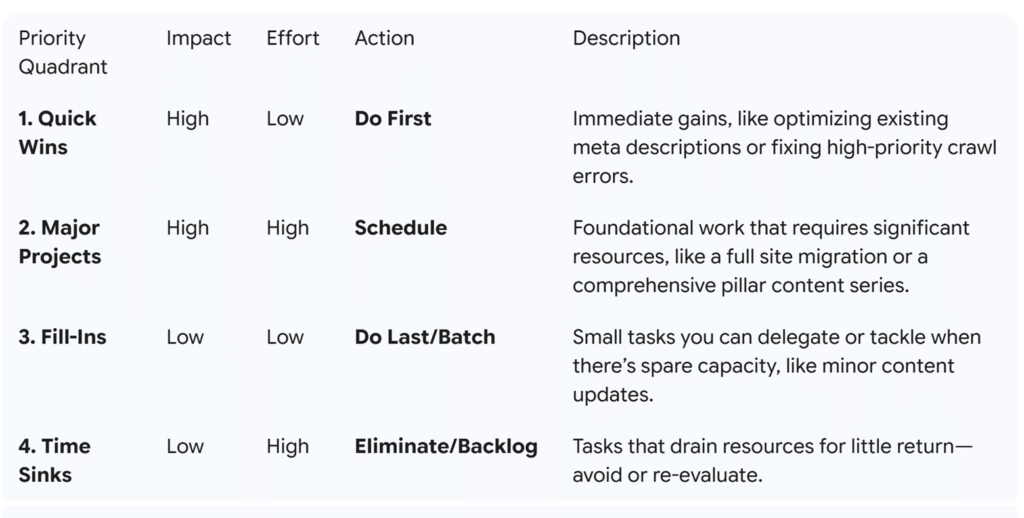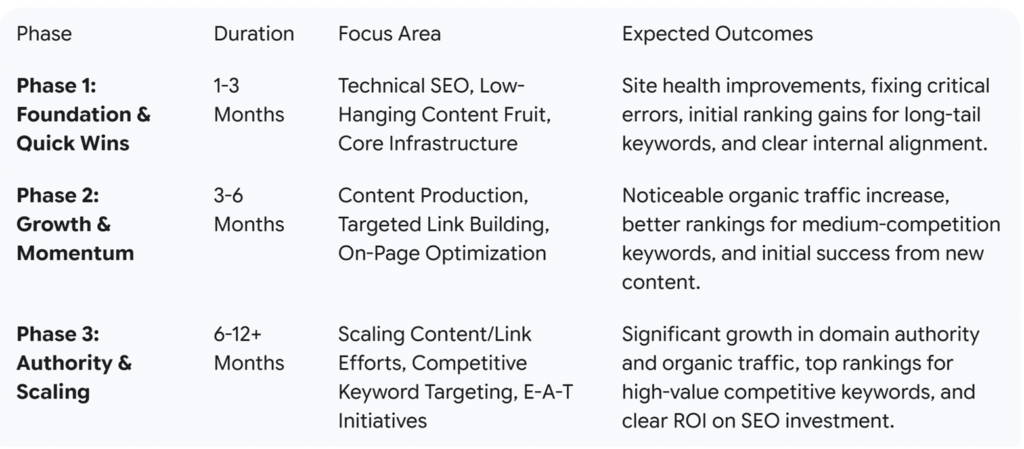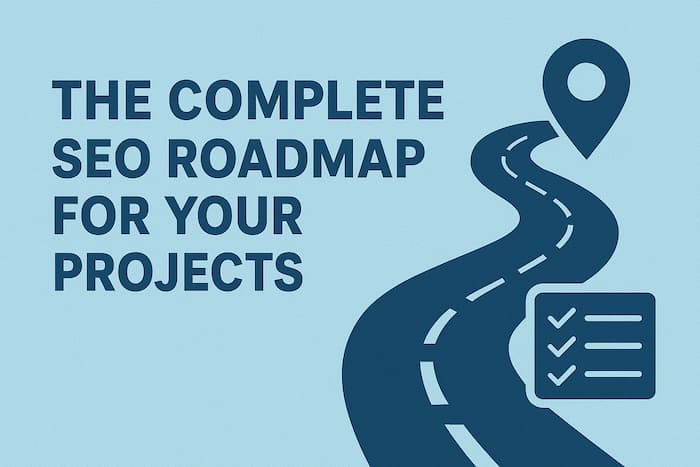SEO is not a magic switch you flip; it’s a marathon, not a sprint. Any sustainable digital marketing effort requires structure, foresight, and a clear plan of action. This is where the SEO Roadmap comes in – it is your essential blueprint for maximizing your project’s search visibility and achieving long-term organic growth.
Without a structured plan, your SEO efforts can quickly become disjointed, leading to wasted time and missed opportunities. This comprehensive guide breaks down the concept, components, and steps to build a bulletproof SEO roadmap, ensuring every SEO task you execute drives you closer to your ultimate business goals.
What is an SEO Roadmap?
An SEO roadmap is a strategic, structured plan of action that outlines the specific tasks, initiatives, resources, priorities, and estimated timelines required to achieve your overarching SEO objectives within a defined period (typically 6-12 months).
Think of it as a living document and a communication tool. It takes the broad goals of your SEO strategy and translates them into a sequential, actionable project plan. It provides a clear, visual overview of the how, when, and who for every SEO task, from technical audits and content creation to link building and performance reporting.
It ensures that all stakeholders – from content writers and developers to marketing managers – are aligned on what needs to be done, when it’s due, and what impact is expected.
The Critical Difference: SEO Strategy vs. SEO Roadmap
While the terms are often used interchangeably, they serve distinct, yet interconnected, purposes:
| Feature | SEO Strategy | SEO Roadmap |
| Focus | The “What” and “Why” | The “How” and “When” |
| Purpose | Defines the overarching business goals and the high-level approach to achieve them (e.g., increase qualified organic leads). | Translates the strategy into concrete, sequenced action items, timelines, and deliverables. |
| Scope | Broad and conceptual; a framework for decision-making. | Detailed, tactical, and execution-focused; a project management tool. |
| Examples | Focus on Technical SEO, Content Creation, and Link Building to establish authority in the niche. | Complete Technical Audit (Q1), publish 12 pillar articles (Q2-Q4), launch Digital PR campaign (Q3). |
In short: Your Strategy dictates what your team should focus on to win. Your Roadmap is the project plan your team uses to actually execute that winning strategy.
Benefits of Building an SEO Roadmap
Creating a detailed SEO roadmap is an investment that yields significant returns across your project:
- Alignment & Stakeholder Buy-In: It clearly articulates the plan to non-SEO stakeholders (like executive leadership or development teams), making it easier to secure resources and prioritize SEO tasks over competing projects.
- Resource Management: By assigning timeframes and ownership to specific tasks, you can effectively allocate budget, team members, and tools, preventing bottlenecks and burnout.
- Proactive vs. Reactive: It shifts your SEO efforts from constantly reacting to algorithm changes or site issues to proactively executing a planned, high-impact agenda.
- Clear Prioritization: It forces you to evaluate tasks based on their potential impact and required effort, ensuring you work on the highest-value items first (e.g., quick wins before long-term foundational work).
- Measurable Progress: With milestones and timelines built-in, you have clear benchmarks to track progress, measure performance, and adjust your plan as needed.
Components of an SEO Roadmap
An effective SEO roadmap is broken down into workstreams that align with the three main pillars of SEO.
1. Technical SEO Workstream
This technical SEO focuses on optimizing the non-content elements of your site to ensure search engines can crawl, index, and render your pages efficiently.
- Audit Findings: A prioritized list of technical issues (e.g., crawl errors, broken links, page speed concerns).
- Site Health Improvements: Tasks related to Core Web Vitals (LCP, FID, CLS), mobile-friendliness, and HTTPS implementation.
- Site Architecture: Plans for improving URL structure, internal linking, and XML sitemap optimization.
- Structured Data: Implementation plans for Schema markup to enhance SERP visibility.
2. Content SEO Workstream
This is dedicated to improving the quantity, quality, and relevance of the content on your site to meet user search intent.
- Keyword Research & Mapping: Identifying primary and secondary target keywords and mapping them to specific pages.
- Content Audit & Optimization: Plans for refreshing, merging, or deleting existing low-performing content.
- Content Calendar: A schedule for new high-value content production (e.g., pillar pages, blog posts, guides) based on topical authority.
- On-Page Optimization: Tasks like optimizing title tags, meta descriptions, headings, and images for new and existing content.
3. Off-Page SEO Workstream
This focuses on activities outside of your website to improve its authority and reputation.
- Link Building Strategy: Campaigns for earning high-quality backlinks (e.g., broken link building, digital PR, resource page outreach).
- Brand Mentions & Citations: Strategy for managing and gaining local citations and unlinked brand mentions.
- E-A-T (Expertise, Authoritativeness, Trustworthiness): Initiatives to feature authors, secure expert quotes, and build trust signals.
7 Steps to Build Your SEO Roadmap
The process of building your roadmap moves systematically from assessment to execution.
Step 1: Define Your SMART SEO Goals
Before listing tasks, define what success looks like. Your goals must be Specific, Measurable, Achievable, Relevant, and Time-bound. They must align with your overall business objectives (e.g., increase qualified organic leads by 30% within the next 12 months).
Step 2: Conduct Comprehensive SEO Audits
This is the discovery phase. Run a full audit of your current performance, covering all three components:
- Technical Audit: Use tools like Google Search Console and Screaming Frog to find errors.
- Content Audit: Identify content gaps, cannibalization issues, and low-performing pages.
- Competitive Analysis: See where your competitors are succeeding (keywords, links, content formats).
Step 3: Compile a Master List of Actionable Tasks
Based on your goals and audit findings, list every single SEO action item that needs to be addressed. Do not filter yet; just brain dump everything, no matter how small or large.
Step 4: Prioritize Tasks (The Quick Wins First!)
This is the most critical step. Not all tasks are created equal. Use a prioritization framework, such as the Impact vs. Effort Matrix:
| Priority Quadrant | Impact | Effort | Action | Description |
| 1. Quick Wins | High | Low | Do First | Immediate gains, like optimizing existing meta descriptions or fixing high-priority crawl errors. |
| 2. Major Projects | High | High | Schedule | Foundational work that requires significant resources, like a full site migration or a comprehensive pillar content series. |
| 3. Fill-Ins | Low | Low | Do Last/Batch | Small tasks you can delegate or tackle when there’s spare capacity, like minor content updates. |
| 4. Time Sinks | Low | High | Eliminate/Backlog | Tasks that drain resources for little return—avoid or re-evaluate. |

Step 5: Assign Resources and Ownership
Assign a clear owner (a team or individual) and estimate the required resources (time, budget, development support) for each prioritized task.
Step 6: Create the SEO Timeline (Phased Approach)
Organize your prioritized tasks into a phased, chronological timeline. This is the Roadmap view, often organized by quarters (Q1, Q2, Q3, Q4) or months.
SEO Timeline: Setting Realistic Expectations
SEO results take time to compound. Setting realistic expectations for your timeline is crucial for stakeholder satisfaction.
| Phase | Duration | Focus Area | Expected Outcomes |
| Phase 1: Foundation & Quick Wins | 1-3 Months | Technical SEO, Low-Hanging Content Fruit, Core Infrastructure | Site health improvements, fixing critical errors, initial ranking gains for long-tail keywords, and clear internal alignment. |
| Phase 2: Growth & Momentum | 3-6 Months | Content Production, Targeted Link Building, On-Page Optimization | Noticeable organic traffic increase, better rankings for medium-competition keywords, and initial success from new content. |
| Phase 3: Authority & Scaling | 6-12+ Months | Scaling Content/Link Efforts, Competitive Keyword Targeting, E-A-T Initiatives | Significant growth in domain authority and organic traffic, top rankings for high-value competitive keywords, and clear ROI on SEO investment. |

Tools for Your SEO Roadmap
To execute and manage your roadmap, you’ll need the right tools for research, project management, and reporting:
SEO Research & Audit Tools
- Google Search Console (Free): Essential for technical monitoring (crawl errors, indexing, Core Web Vitals).
- Google Analytics (Free): Crucial for tracking performance, traffic, and conversions.
- SEMrush / Ahrefs / Moz: All-in-one tools for keyword research, competitor analysis, and backlink auditing.
- Screaming Frog: Excellent for deep-dive technical audits (crawl structure, redirects).
Project Management Tools
- Asana / Trello / ClickUp: Ideal for organizing tasks, assigning owners, setting deadlines, and tracking progress against your roadmap.
- Google Sheets / Excel: Perfect for the initial master task list, prioritization matrices, and simple timeline visualization.
Reporting Tools
- Google Data Studio (Looker Studio): For creating visual, dynamic dashboards that report roadmap progress against your SMART goals.
Final Thoughts
An SEO roadmap is more than a checklist; it’s a commitment to structured, data-driven execution. By dedicating time upfront to audit, strategize, and prioritize, you create a clear, measurable path for your project to thrive in the competitive world of search.
Start building your roadmap today, and transform your ambitious SEO strategy into a reality of consistent organic growth.

